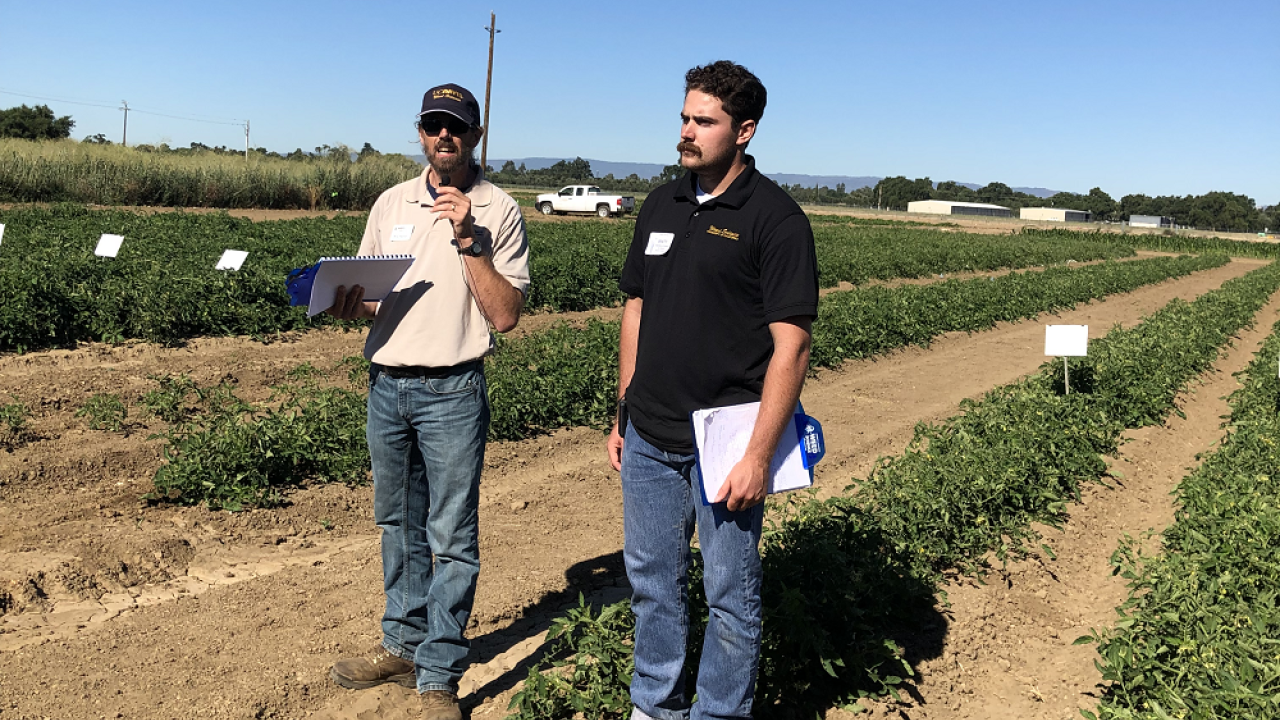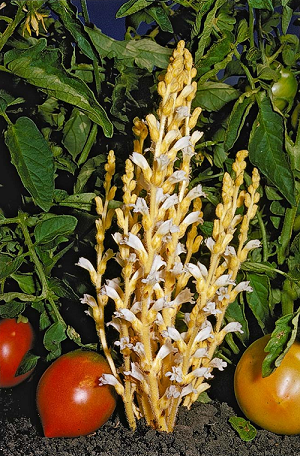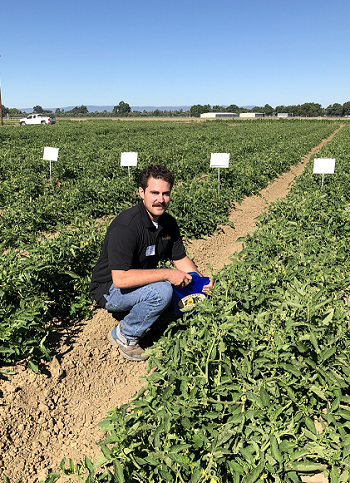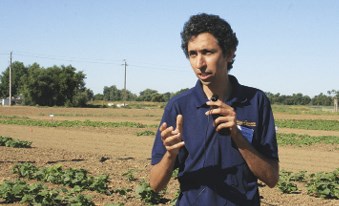
Broomrape Eradication is High Priority for UC Researchers

Processing tomato growers are struggling to contain a potentially devastating parasitic weed that had not been seen since growers waged a successful eradication campaign four decades ago.
Branched broomrape is so destructive in tomatoes that if it is detected in a grower’s field, quarantine regulations require that the crop be destroyed and the field be disked under, and common sense dictates that a grower rotate out of host crops for many years, said Brad Hanson, UC Cooperative Extension weed specialist, Department of Plant Sciences, UC Davis.
And even that may not be enough to prevent a resurgence of branched broomrape, which causes crop losses in processing tomatoes of up to 70 percent and even 80 percent.
“You could plant non-host crops for 20 years, but then when you plant tomatoes, branched broomrape could emerge again,” Hanson said. “It produces a large number of tiny seeds and many of them are long-lived.”
Hanson is part of a team of UC researchers enlisted by the processing tomato sector to work on a plan to contain the damage caused by branched broomrape, should it become established enough that the California Department of Food and Agriculture zero-tolerance quarantine strategy is replaced by management programs.
This parasitic weed, unable to produce its own chlorophyll, survives only by attaching to the roots of a host plant, often with severe consequences.
Branched broomrape has recently been detected in isolated fields in Yolo, Solano and San Joaquin counties, but the processing tomato business has a history of investing in efforts to eradicate this potentially disastrous weed.

“From 1973 to 1982, the California Tomato Research Institute and the industry as a whole spent over $1.5 million on research, surveying and fumigation to achieve eradication levels of this same pest,” said Zach Bagley, CTRI managing director. “These efforts were so successful that no industry dollars have gone to this problem since then, until now.”
Bagley urged growers and pest control advisors to be vigilant in avoiding spread of this weed to new fields.
“Broomrape is easily spread by equipment, boots and water,” he said. “It is a prolific seed producer. One plant can produce over 100,000 seeds only 0.3 millimeters long. Broomrape seed has been documented to last in the soil for at least 35 years.”
Once ground has been infested, crop options for the field are extremely limited for a long period of time.
“The host range of broomrape, in addition to tomato, covers a number of economically important rotational crops in the Central Valley: safflower, sunflower, carrot, bell pepper, several Brassica species, lettuce, several bean crops, melon, potato, olive and many common weeds,” according to Bagley.
Hanson and fellow researchers UC Davis assistant professor Mohsen Mesgaran and graduate student Matthew Fatino discussed their progress toward a management strategy during the 63rd annual Weed Day on the Davis campus.
They are attempting to learn if a timely application of an herbicide at a rate high enough to stunt the broomrape, but low enough to spare the tomatoes, can be an effective strategy to minimize crop losses.
“We’re trying to get a relatively low rate of material into the crop, high enough to kill the parasitic weed but low enough to not damage the crop,” Hanson said. “One of the materials we are trying is registered in California on wheat, and another is not registered in this state. We are trying to hedge our bets, in terms of registering something we can use on tomatoes.”
One step in the research is to learn if the tomatoes can grow through low level applications of the candidate herbicides.
“This is a crop phyto trial, and so far, so good,” Fatino said as he looked over tomato plots in test fields on the UC Davis campus that had been treated with very low rates of a number of weed killers. “If this works, it will be easy to implement through the fertilizer system.”

An important piece of this research is identifying the best time to apply an herbicide to slow down the broomrape with a minimum of damage to the tomatoes.
“It’s a root parasite; it cannot produce its own chlorophyll,” Fatino said. “Israeli researchers developed a temperature/moisture model for application of low rates of an ALS inhibitor on processing tomatoes. We want to time the application to when the broomrape attaches to the tomato roots.”
Researchers are conducting the germination studies to develop a model for the right application time in the UC Davis Contained Research Facility, which is designed to prevent escape of the weed.
“We are trying to predict the timing of germination of broomrape based on the soil temperature and moisture,” Mesgaran said. “The timing of herbicide application is essential.”
If successful, these studies could develop a strategy to limit the damage from broomrape if it becomes established and the strict quarantine is lifted.
“This is not eradication,” Hanson said. “This is how can we live with this without huge yield losses. That’s what the Israelis do; they went from 70 percent yield losses to very modest losses they can live with.”
The regulatory consequences of having this quarantine pest discovered are so draconian there may be a temptation to keep the finding secret, Hanson said.
“There have been some known cases in the Sacramento Valley, but I think it’s more than reported,” Hanson said. “It’s not a huge problem, but it’s not a small one either, and I think it’s under-reported because it requires crop destruct. In the fields I am aware of, the crop was destroyed, the field disked under and methyl bromide applied. It cost around $6,000 an acre.”
Tempting as it may be to keep an infestation secret, the consequences of risking spread of broomrape could be disastrous.
“Although these industry efforts are important, the most effective means to control the spread of this pest is active concern for the presence of this weed in processing tomato fields,” Bagley said. “Should you discover broomrape in a field, please contact the grower immediately, who should in turn contact the respective county agricultural commissioner. The harvest of infested fields or blocks, because of the biology of this weed and its standing as a California Department of Food and Agriculture Class A status, is extremely ill-advised.”
Original article from AgAlert, California Farm Bureau Federation.
